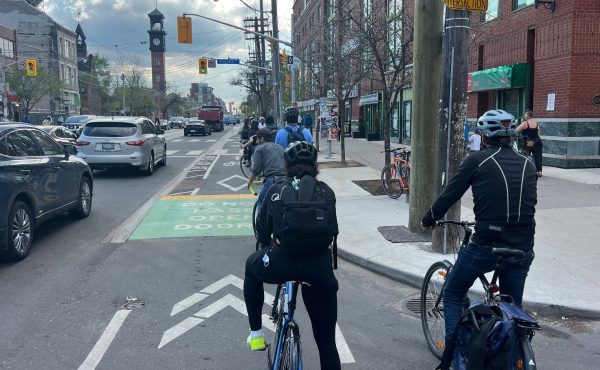
In late September, I had the privilege of sitting in on one of the walkability studies that are taking place in conjunction with the City’s Tower Renewal pilot project. The studies enable residents of the tower neighbourhoods that are part of the pilot project to show how they walk in their area and what the barriers are to walking, with a view to discovering potential improvements. They have been developed by Jane Farrow of the Centre for City Ecology and Prof. Paul Hess of the University of Toronto.
The site was a set of four towers organized around Cougar Court in Scarborough Village, just off Eglinton East near Kingston Road. The first thing Jane Farrow showed us when we arrived was a classic piece of suburban unwalkability. Just east of the four towers, which house over a thousand people including many children, there is an elementary school and a park on Gatesview Ave. But a string of houses along Cedar Dr. were built along the east side of the towers complex blocking direct access to these amenities (full satellite map). Residents of the towers would have to take a roundabout route (especially for those in the north towers) through a pedestrian-unfriendly alley to the south to get to them.

Fortunately, though, one of the houses along Cedar Dr. is abandoned (where all the trees can be seen). A hole has been cut in the fence behind the towers…

…and a very well-trodden path has been created to provide the tower residents with a direct route to the school and the park.

When they were participating in the walkability study, the local children all said the house is haunted, and the adults too often referred to the house as “the haunted house.”
What’s remarkable, though, is that although the path is informal (and technically illegal), the volume of pedestrians crossing Cedar Dr. at the end of this path is so great that the City put a crosswalk there — at the end of an unofficial path — to enable people to cross safely on their way to the school and the park. (You can see the end of the path and the crosswalk in the close-up satellite photo).

Obviously what the City needs to do is expropriate this house and create a formal pathway and little linear park linking the tower neighbourhood directly and safely to the places its residents (especially children) want and need to go.

It’s not just for convenience — not only were the children a little intimidated to use the pathway (for good reason — it is potentially dangerous for mundane reasons, in addition to possible haunting), but the adults expressed reluctance to use it because they knew it crossed private property and using it was therefore trespassing. They should not be subjected to this kind of ambiguous situation when a solution exists (and when the City has already essentially acknowledged the need for this path by putting in a crosswalk).
I don’t know what the situation is with the ownership of the house — possibly the City doesn’t know either. (Apparently, if the property owner hasn’t paid his property taxes for three years, the City can issue a warning and, if they’re not paid off in a year, seize the property, but then it has to auction it off (and pay the owner the difference), which wouldn’t bring it into the public realm, where it should be).
In the meantime, someone has quixotically repaired the fence. Already resourceful locals have build a kind of ladder to get over the new fence — Paul Hess calls this kind of thing “informal infrastructure.” No doubt a hole will reappear soon.

Bottom photo by Jane Farrow. Satellite photos taken from Google Maps. Other photos by Dylan Reid.




5 comments
Cul-de-sacs were supposed to be children friendly and protect pedestrians from cars, but instead end up being more car oriented. Fences are climbed or holes created for foot traffic because of the bad road design. The city should buy properties and create walkways for better foot access on the badly designed roads.
Thank you for this, it is a fascinating micro example of where are city just doesn’t seem to be planned well. The area in question seems like one that is struggling – poorer neighbourhoods to the north abut wealthy ones to the south. Scarborough Golf Club nearby is a blight – severing an otherwise continuous park system.
This is an interesting article, but I am not sure that the presence / location of the crossover is directly correlated to people short-cutting through that property. You can find an air photo dating back to 1999 using the City’s online map, which clearly shows the crossover dates back 10 years or more, and seems to show that property in a better state of repair (compare the condition of that loop driveway in the air photo with what you see in the photos above or in Google Street View). (The presence of trees in the air photo isn’t an indicator that things are overgrown — looking at the architecture and property fabric you can tell that that property, and the one immediately north, predate most of the rest of the surrounding subdivision and so it would not be unusual for them to have mature trees.)
The crossover was more likely located there not because it’s at the end of an informal path (which may not even have existed when the crossover was installed), but because it’s at the end of Gatesview Ave., which is the only route to the school for students living west of Cedar Dr. — you would have a lot of students crossing there regardless of the informal path.
That is not to say that it isn’t preferable to have pedestrian paths that are as direct as possible, and that this is usually more of a problem in this type of suburban environment… but I don’t think the conclusions re: cause and effect are necessarily correct.
Great article. I have a bit of an issue with the assumption that “[o]bviously what the City needs to do is expropriate this house and create a formal pathway.” The image of a future in which there are no informal pathways is a bit frightening!
Regardless, there are examples of this in the core. Walking from the Dufferin subway stop to the Dufferin Mall is a very clear example of poor planning and people ‘re-writing’ the plan.
In the Google street view link below you can see the path the school has provided, but rotate 180 degrees and you’ll see where the woman and dog end up… If it weren’t so sad, it’d be funny.
mall
This is a fascinating article. Who would fix the fence of the abandoned property???